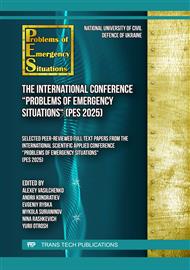[1]
V. Ustymenko, Y. Rohozian, O. Trehub, P. Liashenko, D. Zablodska, Economic and legal dimension of humanitarian demining of Ukraine: problem and research prospects. Amazonia Investiga. 12(65) (2023) 287–295.
DOI: 10.34069/ai/2023.65.05.27
Google Scholar
[2]
Y. Rohozian, K. Sieriebriak, Y. Akhromkin, M. Plietnov, V. Vakhlakova, International Determinants of Demining Territories in the Context of Sustainable Development: Economic Projection. Problemy Ekorozwoju. 19(2) (2024) 203–214.
DOI: 10.35784/preko.6202
Google Scholar
[3]
AW. Dorn, Eliminating Hidden Killers: How Can Technology Help Humanitarian Demining? Stability: International Journal of Security & Development. 8(1) 5 (2019) 1–17.
DOI: 10.5334/sta.743
Google Scholar
[4]
L. Ekenberg, T. Fasth, A. Larsson, Hazards and quality control in humanitarian demining, International Journal of Quality & Reliability Management. 35 4 (2018) 897–913.
DOI: 10.1108/ijqrm-01-2016-0012
Google Scholar
[5]
M.I. Hassan, D. Ahmat, S. Ouya, Technologies Behind the Humanitarian Demining: A Review, 2024 International Conference on Smart Applications, Communications and Networking (SmartNets). Harrisonburg, VA, USA. (2024) 1–7.
DOI: 10.1109/smartnets61466.2024.10577706
Google Scholar
[6]
C. Camacho-Sanchez, R. Yie-Pinedo, G. Galindo, Humanitarian demining for the clearance of landmine-affected areas. Socio-Economic Planning Sciences. 88 (2023) 101611.
DOI: 10.1016/j.seps.2023.101611
Google Scholar
[7]
S. Mahmood, S. Scharoba, J. Schorlemer, C. Schulz, M. Hübner, M. Reichenbach, Detecting improvised land-mines using deep neural networks on GPR image dataset targeting FPGAs. In 2022 IEEE Nordic Circuits and Systems Conference (NorCAS). (2022) 1–7.
DOI: 10.1109/norcas57515.2022.9934735
Google Scholar
[8]
X. Gao, J. W. Podd, D.J. Daniels, A.J. Peyton, Combining Electromagnetic Spectroscopy and Ground-Penetrating Radar for the Detection of Anti-Personnel Landmines. Sensors. 19 (2019) 3390.
DOI: 10.3390/s19153390
Google Scholar
[9]
A. Machado Brito-da-Costa, D. Martins, D. Rodrigues, L. Fernandes, R. Moura, Á. Madureira-Carvalho, Ground penetrating radar for buried explosive devices detection: A case studies review. Australian journal of forensic sciences. 54(4) (2022) 559–578.
DOI: 10.1080/00450618.2020.1865453
Google Scholar
[10]
J. Baur, G. Steinberg, A. Nikulin, K. Chiu, T. S. de Smet, Applying deep learning to automate UAV-based detection of scatterable landmines. Remote Sensing. 12(5) (2020) 859.
DOI: 10.3390/rs12050859
Google Scholar
[11]
I. Nevliudov, D. Yanushkevych, L. Ivanov, Analysis of the state of creation of robotic complexes for humanitarian demining. Technology Audit and Production Reserves. 6(2(62) (2021) 47–52
DOI: 10.15587/2706-5448.2021.245803
Google Scholar
[12]
A. Karpov, M. Kustov, O. Basmanov, O. Kulakov, Investigation of Diffraction of Electromagnetic Microwaves on Explosive Materials. Advances in Science and Technology. 156 (2024) 91–102.
DOI: 10.4028/p-cg2mbv
Google Scholar
[13]
M. Kustov, A. Karpov, S. Harbuz, A. Savchenko, Effect of Physical and Chemical Properties of Explosive Materials on the Conditions of their Use. Key Engineering Materials. 952 (2023) 143-154.
DOI: 10.4028/p-0h8ung
Google Scholar
[14]
R. Firoozabadi, E. L. Miller, C. M. Rappaport, A.W. Morgenthaler, Sub-surface sensing of buried objects under a randomly rough surface using scattered electromagnetic field data IEEE Trans on Geoscience and Remote Sensing. 45 1 (2007) 93–104.
DOI: 10.1109/tgrs.2006.883462
Google Scholar
[15]
Ch. Müller, M. Scharmach, M. Gaal, D. Guelle, A. Lewis, A. Sieber, Performance demonstration for humanitarian demining: Test and evaluation of mine searching equipment in detecting mines. Materials Testing. 45 11–12 (2003) 504–512.
DOI: 10.1515/mt-2003-0004
Google Scholar


